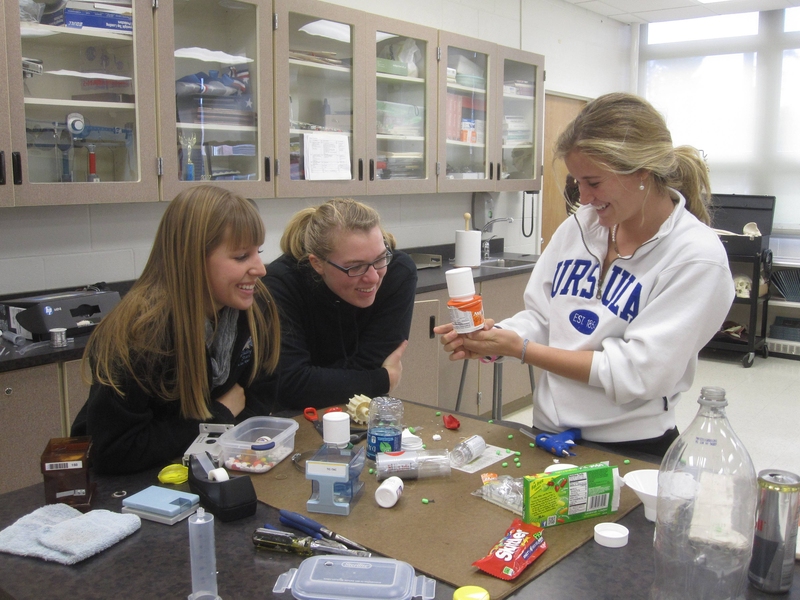Engaging young Americans in science, technology, engineering and math (STEM) continues to be a key strategy to maintaining the United States' position as a global leader. Yet a 2011 report by the U.S. Department of Commerce found that nearly half of the U.S. workforce — women — continues to be a minority in STEM fields, holding less than 25 percent of jobs. The same report found that women hold a disproportionately low share of STEM undergraduate degrees, particularly in engineering.
The Lemelson-MIT Program is helping to address this gender gap, awarding — based on technical merit — three all-girl schools up to $10,000 in grant funding as part of the 2012-2013 InvenTeam initiative. Sixteen teams total comprised of students, teachers and mentors will pursue year-long invention projects that address real-world problems. Now in its 10th year as a national grants program, InvenTeams aims to inspire a new generation of inventors by engaging participants in creative thinking, problem-solving and hands-on learning in STEM.
"The gender gap within STEM fields can be attributed, in part, to the need for more female role models in related careers," said Joshua Schuler, executive director of the Lemelson-MIT Program. "Hands-on learning programs that reach young women and men, like Lemelson-MIT's InvenTeam initiative, ensure that we continue to grow our future pool of science and technology leaders and icons."
Proposed by public, private, charter, and home-based school teams from around the country, this year's inspiring InvenTeam projects include the invention of a life jacket for prolonged search and rescue, a bacteria-powered battery and an ozone water purification system. Through the InvenTeam process, students develop leadership, teamwork and technical building skills, while engaging with professionals from industry and academia in their communities as they develop their invention. Through their InvenTeam experiences, Students gain the skills necessary to be competitive and successful in both their education and careers.
"This year's projects, from inventions for environmental sustainability to those for health and safety, show that young Americans are not just motivated to invent, but are committed to improving the lives of others through invention," said Leigh Estabrooks, the Lemelson-MIT Program's invention education officer. "Our goal with InvenTeams is to help inspire both men and women to be future inventors."
Meet the 2012–13 InvenTeams
A respected panel of invention and academic leaders from MIT, the Lemelson-MIT Program, industry and InvenTeam student alumni selected the InvenTeams from a national pool of applicants. The 2012–13 Lemelson-MIT InvenTeams and their proposed inventions are:
East
Calling all young inventors
The Lemelson-MIT InvenTeam application for the 2013–14 school year is now available at http://web.mit.edu/inventeams/. Teams of high school students, teachers and mentors are encouraged to apply.
The Lemelson-MIT Program is helping to address this gender gap, awarding — based on technical merit — three all-girl schools up to $10,000 in grant funding as part of the 2012-2013 InvenTeam initiative. Sixteen teams total comprised of students, teachers and mentors will pursue year-long invention projects that address real-world problems. Now in its 10th year as a national grants program, InvenTeams aims to inspire a new generation of inventors by engaging participants in creative thinking, problem-solving and hands-on learning in STEM.
"The gender gap within STEM fields can be attributed, in part, to the need for more female role models in related careers," said Joshua Schuler, executive director of the Lemelson-MIT Program. "Hands-on learning programs that reach young women and men, like Lemelson-MIT's InvenTeam initiative, ensure that we continue to grow our future pool of science and technology leaders and icons."
Proposed by public, private, charter, and home-based school teams from around the country, this year's inspiring InvenTeam projects include the invention of a life jacket for prolonged search and rescue, a bacteria-powered battery and an ozone water purification system. Through the InvenTeam process, students develop leadership, teamwork and technical building skills, while engaging with professionals from industry and academia in their communities as they develop their invention. Through their InvenTeam experiences, Students gain the skills necessary to be competitive and successful in both their education and careers.
"This year's projects, from inventions for environmental sustainability to those for health and safety, show that young Americans are not just motivated to invent, but are committed to improving the lives of others through invention," said Leigh Estabrooks, the Lemelson-MIT Program's invention education officer. "Our goal with InvenTeams is to help inspire both men and women to be future inventors."
Meet the 2012–13 InvenTeams
A respected panel of invention and academic leaders from MIT, the Lemelson-MIT Program, industry and InvenTeam student alumni selected the InvenTeams from a national pool of applicants. The 2012–13 Lemelson-MIT InvenTeams and their proposed inventions are:
East
- ACTS Home Education Cooperative (Charlottesville, Va.): Wind turbine for traffic airflow capture
- Beaver Country Day School (Chestnut Hill, Mass.): Automated robotic vehicular independence system
- Ella T. Grasso Southeastern Technical High School (Groton, Conn.): Compost water heating system
- John P. Stevens High School (Edison, N.J.): Life jacket for prolonged search and rescue
- Nashua High School North (Nashua, N.H.): Bacteria-powered battery
- Natick High School (Natick, Mass.): Ice search and rescue remotely-operated vehicle
- Newton North High School (Newton, Mass.): Pedestrian alert system
- Sturgis West Charter Public School West (Hyannis, Mass.): Marine mammal rescue transporter
- Thomas Jefferson High School for Science and Technology (Alexandria, Va.): Emotive aid for combating autism
- LEARN Science and Math Academy (Kansas City, Mo.): Radio frequency identification system for medicine tracking
- St. Ursula Academy (Toledo, Ohio): Pill dispensing organizational system
- Ann Richards School for Young Women Leaders (Austin, Texas): Pressurized produce preserver
- Colfax High School (Colfax, Calif.): Construction layout tool
- Girls Leadership Academy of Arizona (Phoenix, Ariz.): Drowning prevention device
- Henry M. Gunn High School (Palo Alto, Calif.): Solar egg incubator
- Los Alamitos High School (Los Alamitos, Calif.): Ozone water purification system
Calling all young inventors
The Lemelson-MIT InvenTeam application for the 2013–14 school year is now available at http://web.mit.edu/inventeams/. Teams of high school students, teachers and mentors are encouraged to apply.






